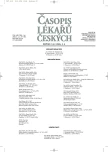Je tamoxifen porfyrinogenní?
Is Tamoxifene Porphyrinogenic?
Background.
As reported in previous studies, porphyria cutanea tarda (PCT) developed in several tamoxifene-treated patients with breast cancer. We studied the group of patients with cancer having only tamoxifene therapy after the initial surgery. We evaluated their clinical and laboratory results and compared them with the results of the group of patients suffering also from breast tumor, but treated after the surgery with other systemic therapies , mostly with chemotherapy.
Methods and Results.
20 patients were complexly studied, 10 of them with only tamoxifene therapy, and 10 without it. Diagnosis of the breast tumor was histologically confirmed in all of them. With the use of laboratory methods we examined their urinary excretion of diagnostically important porphyrins (uro- and coproporphyrin), then total blood count, liver function tests (ALT and AST), blood sugar, cholesterin, serum iron and ferritin, and performed also urinanalysis and detection of possible anti-HCV antibodies. The laboratory examination was repeated in the patient subgroup after three months, urinary uro- and coproporphyrin excretion also in the the control group, for to have an opportunity to follow the dynamics of laboratory changes. All the patients were examined during their regular laboratory controls performed so as not to be bothered with repeated additional phlebotomies. We did not confirm in our patients suffering from breast tumor the results of other autors, suggesting the connection between tamoxifene-therapy and development of porphyria cutanea tarda.
Conclusions.
Isolated cases of PCT can be induced through the effect of various hepatotoxic factors. However, the influence of common porphyrinogenically acting noxious substances (alcohol, HCV virus or iron overload as a result of the HFE gene mutations) were not found in our patients.
Key words:
tamoxifene, porphyria cutanea tarda, PCT, estrogenic hormons, cytostatic drugs, breast carcinoma.
Autoři:
L. Malina; V. Mottl 1; H. Michalíková 2
Působiště autorů:
Katedra dermatovenerologie IPVZ, Praha
; Gynekologicko-porodnická klinika 3. LF UK a FNKV, Praha
1; Dermatovenerologická klinika 3. LF UK a FNKV, Praha
2
Vyšlo v časopise:
Čas. Lék. čes. 2005; 144: 262-264
Kategorie:
Původní práce
Souhrn
Východisko.
Na základě referencí o možné porfyrinogenitě tamoxifenu jsme se rozhodli provést klinickou a laboratorní studii, v níž jsme vyšetřili skupinu tímto lékem dlouhodobě léčených žen s karcinomem mammy, které po úvodní operaci, případně aktinoterapii neměly žádnou celkovou antineoplastickou medikamentózní terapii. Výsledky získané u nemocných této skupiny jsme porovnali s výsledky u stejně četné skupiny nemocných s diagnózou nádoru prsu tamoxifenem neléčených.
Metody a výsledky.
Vyšetřili jsme 20 nemocných (10 s tamoxifenem a 10 bez něj), s histologicky potvrzenou diagnózou nádoru. Laboratorně jsme zjišťovali močovou exkreci uroporfyrinu a koproporfyrinu, krevní koncentraci ferritinu, siderémii, protilátky proti viru hepatitidy C, hodnoty krevního obrazu a diferenciálního rozpočtu; jaterní funkční testy (ALT a AST), glykémii a cholesterolémii. Vyšetřování jsme opakovali s odstupem tří měsíců. Ve studii skupiny dlouhodobě léčných pacientek s karcinomem mammy jsme nepotvrdili nálezy autorů uvádějících do souvislosti manifestaci pozdní kožní porfyrie a terapeutické podávání tamoxifenu.
Závěry.
Tyto případy jsou ojedinělé a mohou nesporně vznikat působením různých hepatotoxicky působících faktorů. Vliv obvyklých porfyrinogenně se uplatňujících příčin vzniku choroby (tj. alkoholu, infekce virem HCV nebo přetížení železem při mutaci genu hereditární hemochromatózy) jsme u našich nemocných nezjistili.
Klíčová slova:
tamoxifen, pozdní kožní porfyrie, PCT, estrogeny, cytostatika, karcinom prsu.
Štítky
Adiktologie Alergologie a imunologie Angiologie Audiologie a foniatrie Biochemie Dermatologie Dětská gastroenterologie Dětská chirurgie Dětská kardiologie Dětská neurologie Dětská otorinolaryngologie Dětská psychiatrie Dětská revmatologie Diabetologie Farmacie Chirurgie cévní Algeziologie Dentální hygienistkaČlánek vyšel v časopise
Časopis lékařů českých

- Metamizol jako analgetikum první volby: kdy, pro koho, jak a proč?
- Horní limit denní dávky vitaminu D: Jaké množství je ještě bezpečné?
- Isoprinosin je bezpečný a účinný v léčbě pacientů s akutní respirační virovou infekcí
Nejčtenější v tomto čísle
- Imprinting genů a lidské patologie
- Těžká otrava olovem po požití broků
- Syndrom Brugada
- Je tamoxifen porfyrinogenní?
